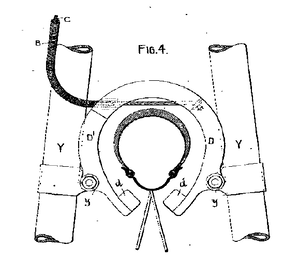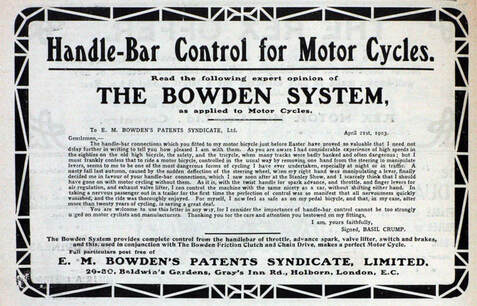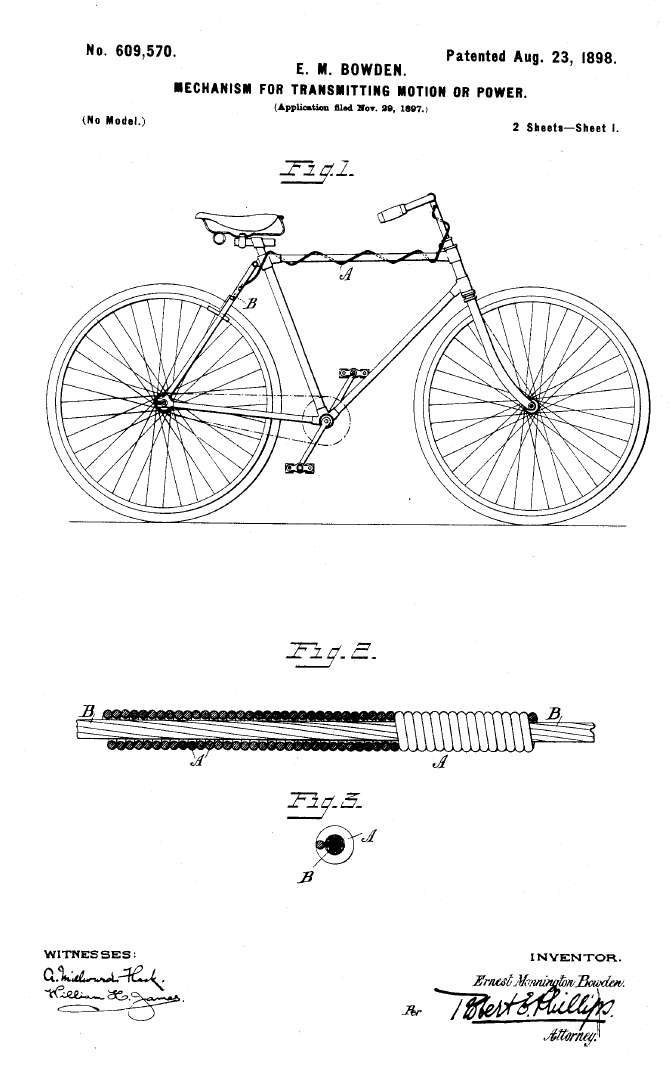 GB 14,402
GB 14,402
On August 23, 1898, U.S. Patent No.: 609,570 issued to Ernest Monnington Bowden for a "Mechanism for Transmitting Motion or Power". The patent was for a mechanism that is now commonly known as the Bowden cable, which is still widely used in bicycles and numerous other applications. As disclosed in the patent, the Bowden cable had a flexible inner cable disposed inside a flexible outer guide tube. The outer guide tube was formed from spirally-coiled wire, while the inner cable was formed from twisted or stranded wires. The inner cable was movable within the outer guide tube when one end of the inner cable was moved by the actuation of a handle or lever mounted on the handlebar of a bicycle. This movement was transferred to the other end of the cable, which was attached to a brake having a slotted friction surface disposed radially inward from a rim of a rear wheel of the bicycle. The movement of the other end of the cable pulled the brake upward to engage the friction surface with the inner surface of the rim, thereby braking the wheel.
Bowden's U.S. patent was based on a British patent GB 25,325, which Bowden applied for on November 11, 1896. Interestingly, the British patent did not disclose the use of the Bowden cable in a bicycle. In both the U.S. patent and the GB patent, the claims (coverage) of the patent were broadly directed to the cable and not to its application, such as in a bicycle.
Later, in 1897, Bowden filed a patent application for a brake for a bicycle or other vehicle that included his inventive cable. This patent application issued in 1898 as GB 14,402 and disclosed a brake that was essentially the modern bicycle brake. The brake included a horseshoe-shaped caliper comprised of two levers pivotally connected to rear forks of the bicycle frame, respectively. The levers had upper ends that overlapped and lower ends with brake pads secured thereto, respectively. When the bowden cable was actuated, the lower ends of the lever moved toward each other and brought the brake pads into engagement with the sides of a rim of a rear wheel.
Bowden's U.S. patent was based on a British patent GB 25,325, which Bowden applied for on November 11, 1896. Interestingly, the British patent did not disclose the use of the Bowden cable in a bicycle. In both the U.S. patent and the GB patent, the claims (coverage) of the patent were broadly directed to the cable and not to its application, such as in a bicycle.
Later, in 1897, Bowden filed a patent application for a brake for a bicycle or other vehicle that included his inventive cable. This patent application issued in 1898 as GB 14,402 and disclosed a brake that was essentially the modern bicycle brake. The brake included a horseshoe-shaped caliper comprised of two levers pivotally connected to rear forks of the bicycle frame, respectively. The levers had upper ends that overlapped and lower ends with brake pads secured thereto, respectively. When the bowden cable was actuated, the lower ends of the lever moved toward each other and brought the brake pads into engagement with the sides of a rim of a rear wheel.

Also in 1897, Bowden incorporated a company called "E.M. Bowden's Patents Syndicate Co. Ltd". At that time, a patent syndicate was a type of patent holding company that was dedicated to obtaining and licensing patents, typically in a particular field, such as automobiles or bicycles. Bowden's syndicate, however, was different from most other patent syndicates in that Bowden's syndicate manufactured, or at least tried to manufacture, vehicle brakes.
By the end of 1900, the Raleigh Cycle Company, the Riley Cycle Company and the Lea Francis company joined Bowden's syndicate to obtain licenses to its patents. In so doing, the Bowden cable and brake quickly became commonplace on bicycles. In 1904, however, Bowden's original British cable patent was revoked for being too broad.
Needless to say, Bowden did quite well financially as a result of his inventions, which is somewhat unusual, considering how he was not trained or educated as an engineer or a mechanic. Indeed, Bowden considered himself a "journalist", as he stated in his original British patent. He graduated from Cambridge in 1881 with a B.A. and traveled to India and Ceylon, where he became interested in archaeology and Buddhist culture. He wrote several books, including "The Imitation of Buddha: Quotations from Buddhist Literature for each Day in the Year" and "The Pocket Guide to Cycling". He also wrote articles on Ceylon archaeology and religion.
Bowden died in 1904 at the young age of 44.
By the end of 1900, the Raleigh Cycle Company, the Riley Cycle Company and the Lea Francis company joined Bowden's syndicate to obtain licenses to its patents. In so doing, the Bowden cable and brake quickly became commonplace on bicycles. In 1904, however, Bowden's original British cable patent was revoked for being too broad.
Needless to say, Bowden did quite well financially as a result of his inventions, which is somewhat unusual, considering how he was not trained or educated as an engineer or a mechanic. Indeed, Bowden considered himself a "journalist", as he stated in his original British patent. He graduated from Cambridge in 1881 with a B.A. and traveled to India and Ceylon, where he became interested in archaeology and Buddhist culture. He wrote several books, including "The Imitation of Buddha: Quotations from Buddhist Literature for each Day in the Year" and "The Pocket Guide to Cycling". He also wrote articles on Ceylon archaeology and religion.
Bowden died in 1904 at the young age of 44.


